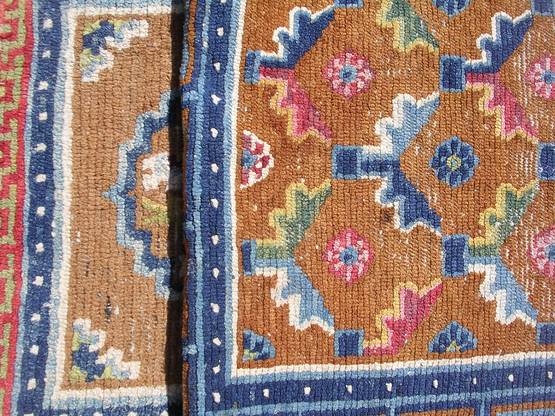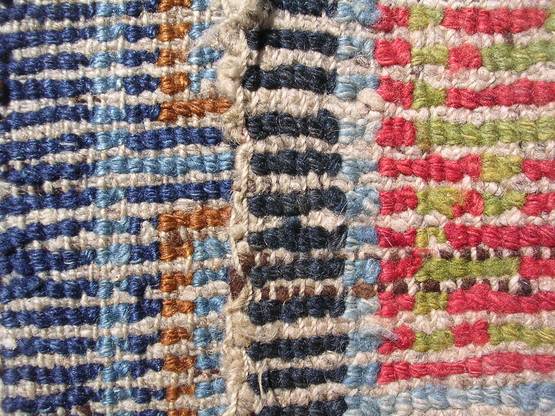Hi Derek, Glenn and others
Thanks again
for your valuable and informative comments.
Glenn, Derek - my
understanding is similar to yours. Tibetans traded rugs and goods and
would have inevitably incorporated ideas and designs from other cultures.
Clearly China has had a great influence on Tibetan designs. With
regard to ‘pure’ and ‘old’, I have seen examples on the Internet which
point to Chinese rugs exhibiting ‘Tibetan’ designs, or e.g. the clouds on
a piece being ‘Tibetan’ rather than Chinese. I start to wonder whether
design swapping is/was a 2 way process?
I’ve got a lot of reading
to do…….
Below are 2 Tibetan (actually the only 2) rugs I own. Some
of you will have seen the khaden on Turkotek before.







Both rugs have all wool
foundation and beautiful natural dyes (I do not detect any synthetics and
all dyes are 100% fast with no bleeding). They are both woven in the
typical Tibetan style.
The longer meditation rug has had both ends
rebuilt and extensive and rather crude repair to the central field of the
centre meditation mat. Despite these condition issues, I bought this
fairly inexpensive piece as I thought it exhibited wonderful colour and
it’s quite rare to find these longer pieces (Most mats are separated and
sold individually). I would imagine this might have been longer as I
believe they were woven with 8 mats.
If you look at the image
comparing the backs, you will see that the meditation rug is woven more
coarsely than the khaden. While both rugs have lovely soft wool and appear
similar on the front, the khaden‘s wool appears shinier on the back in
comparison with the long run. (Perhaps because it’s more tightly woven? Or
perhaps the quality is better?)
It’s hard to tell from these
images but the khaden also has a beautiful cinnamon color field as opposed
to the buff brown field in the mediation rug. The red in the border of the
long rug looks madder derived whereas the reds in the khaden are more
purplish and could be a lac dye. There is a similar but darker purplish
dye in the central floral elements of the meditation rug.
It has
been suggested that the khaden was probably made around 100 years ago for
export. This might account for the better quality in dyes and the tighter
weave. I’d imagine they are both from around 1900, though the meditation
rug might be a little older.
Would anyone care to speculate on
either or both rugs? Both workshop rugs? Age comparison? Region where they
come from?
Regards
Richard Tomlinson